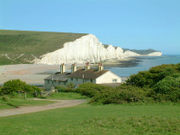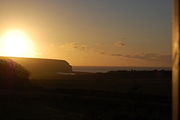Cuckmere Haven
2008/9 Schools Wikipedia Selection. Related subjects: Geography of Great Britain
Cuckmere Haven (also known as the Cuckmere Estuary ) is an area of flood plains in Sussex, England where the river Cuckmere meets the English Channel between Eastbourne and Brighton. The river is an example of a meandering river, and contains several oxbow lakes. It is a popular tourist destination with an estimated 350,000 visitors per year, where they can engage in long walks, or water activities on the river. The beach at Cuckmere haven sits next to the famous chalk cliffs, the Seven Sisters.
At low tides, it is possible to spot ironwork from the sea immediately seaward of the river. This is the wreck of the Polynesia, a German Sail ship, which ran aground somewhere west of Beachy Head, laden with a cargo of nitrate of soda during April 1890.
History
The beach was commonly used by smugglers in the 16th, 17th and 18th centuries. For example, in 1783, two gangs of smugglers (each numbering 200 or 300) overcame officers of the law by weight of numbers and carried away a large quantity of goods.
In the second world war the site was subject to significant attention from the Luftwaffe as they flew missions to identify potential landing sites for the invasion of the UK mainland. As a result a series of counter-landing constructions remains, including numerous pillboxes, anti-tank obstacles, ditches and tank traps. Cuckmere Haven featured heavily in the war effort; at night lights were placed to confuse bombers into thinking they were above Newhaven and an airfield was set up further inland. As well as the permanent constructions the river was heavily mined.
Cuckmere Haven as a film location
The beach at Cuckmere Haven was used for the opening scene in Kevin Costner's Robin Hood, Prince of Thieves and the Seven Sisters cliff face was briefly featured in the Harry Potter film Harry Potter and the Goblet of Fire. The beach was featured in the 2007 film Atonement, a postcard of the lifeboat cottage overlooking the beach was a central element of the plot with Robbie Turner focusing on it as the idyll where he and Cecilia Tallis would retire after World War II. The final sequence of the film with Robbie and Cecilia running in the waves was shot on the beach.
Wildlife
Cuckmere Haven is home to a large variety of wildlife.
Animals
Birds
- Brent goose
- Canada geese
- Common sandpiper
- Green woodpecker
- Grey heron
- Grey wagtail
- Greylag
- Kestrel
- Little egret
- Little grebe
- Meadow pipit
- Oystercatcher
- Pied wagtail
- Pochard
- Redshank
- Reed bunting
- Ringed plover
- Sand martin
- Shelduck
- Short-eared Owl
- Skylark
- Stonechat
- Wigeon


